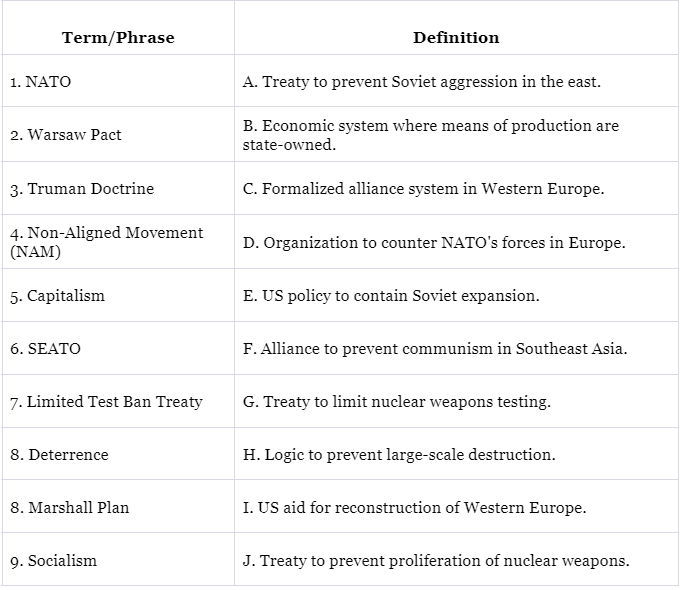Worksheet: From the Beginning of Time | Political Science Class 12 - Humanities/Arts PDF Download
| Table of contents |

|
| Fill in the Blanks |

|
| Match the Column |

|
| Assertion and Reason Based |

|
| Very Short Answer Type Questions |

|
| Short Answer Type Questions |

|
| Long Answer Type Questions |

|
Fill in the Blanks
Q1: The period of international relations from 1945 to 1990 is known as the era of the __________.
Q2: The term Cold War was coined by the scholar ____________.
Q3: Cuba, under the leadership of ____________, became a communist country and ally of the Soviet Union.
Q4: The Cuban Missile Crisis occurred in the year ____________.
Q5: The logic of deterrence during the Cold War aimed to prevent direct conflict due to the ____________ of war.
Q6: ____________ was an economic system where a country's trade and industry were controlled by private owners for profit.
Q7: The organization formed in 1949 to counter Soviet influences in Europe was called ____________.
Q8: The first Non-Aligned Movement (NAM) summit was held in ____________ in the year ____________.
Q9: The Truman Doctrine was aimed at containing ____________ expansion during the Cold War.
Q10: The Limited Test Ban Treaty (LTBT) was signed in the year ____________.
Match the Column
Q1:

Assertion and Reason Based
Q1: Assertion: The Cuban Missile Crisis was a turning point in the Cold War.
Reason: It led to an agreement between the USA and USSR, averting a direct confrontation.
(a) Both Assertion and Reason are True, and Reason is the correct explanation of Assertion.
(b) Both Assertion and Reason are True, but Reason is not the correct explanation of Assertion.
(c) Assertion is True, but Reason is False.
(d) Assertion is False.
Q2: Assertion: NAM should not be confused with isolation or neutrality.
Reason: NAM countries actively participated in international affairs.
(a) Both Assertion and Reason are True, and Reason is the correct explanation of Assertion.
(b) Both Assertion and Reason are True, but Reason is not the correct explanation of Assertion.
(c) Assertion is True, but Reason is False.
(d) Assertion is False.
Q3: Assertion: The logic of deterrence prevented direct conflict during the Cold War.
Reason: Both superpowers knew the cost of war was too high to benefit from it.
(a) Both Assertion and Reason are True, and Reason is the correct explanation of Assertion.
(b) Both Assertion and Reason are True, but Reason is not the correct explanation of Assertion.
(c) Assertion is True, but Reason is False.
(d) Assertion is False.
Q4: Assertion: India's policy of non-alignment allowed it to balance between superpowers.
Reason: India signed treaties with both the USA and USSR to maintain neutrality.
(a) Both Assertion and Reason are True, and Reason is the correct explanation of Assertion.
(b) Both Assertion and Reason are True, but Reason is not the correct explanation of Assertion.
(c) Assertion is True, but Reason is False.
(d) Assertion is False.
Very Short Answer Type Questions
Q1: Briefly explain the concept of the Cold War.
Q2: What was the Truman Doctrine, and why was it significant?
Q3: Name one significant arms control treaty during the Cold War.
Q4: Why did Cuba become a focal point in the Cold War?
Q5: What was the principal function of the Warsaw Pact?
Q6: Define capitalism and socialism.
Q7: What was the purpose of SEATO?
Q8: Why was the Cuban Missile Crisis a high point in the Cold War?
Q9: How did NAM play a role in reducing Cold War conflicts?
Q10: Explain the logic of deterrence during the Cold War.
Short Answer Type Questions
Q1: Explain the Cuban Missile Crisis in detail.
Q2: Describe the formation and purpose of NATO.
Q3: What were the reasons behind the formation of NAM?
Q4: Discuss India's policy of non-alignment during the Cold War.
Q5: Explain the logic of deterrence and its significance during the Cold War.
Q6: Discuss the roles of UNCTAD and NIEO in the context of the Cold War.
Q7: Describe the impact of the Cold War on smaller states and newly independent countries.
Q8: How did the Cold War influence the alliance systems in different regions of the world?
Long Answer Type Questions
Q1: Discuss the emergence of the two power blocs during the Cold War and the reasons states entered into alliances.
Q2: Explain India’s policy of non-alignment during the Cold War and its advantages.
Q3: Describe the role of Non-Aligned Movement (NAM) during the Cold War era and its impact on global politics.
Q4: Explain the concept of deterrence during the Cold War and its role in preventing large-scale conflicts.
You can access the solutions to this worksheet here.
|
34 videos|308 docs|51 tests
|
FAQs on Worksheet: From the Beginning of Time - Political Science Class 12 - Humanities/Arts
| 1. What are the main themes explored in the article "From the Beginning of Time"? |  |
| 2. How does the article address the significance of ancient civilizations? |  |
| 3. What types of questions can be expected in the exam based on this article? |  |
| 4. Can you provide examples of short answer questions that might be included in the exam? |  |
| 5. What study strategies are recommended for preparing for the exam on this article? |  |














